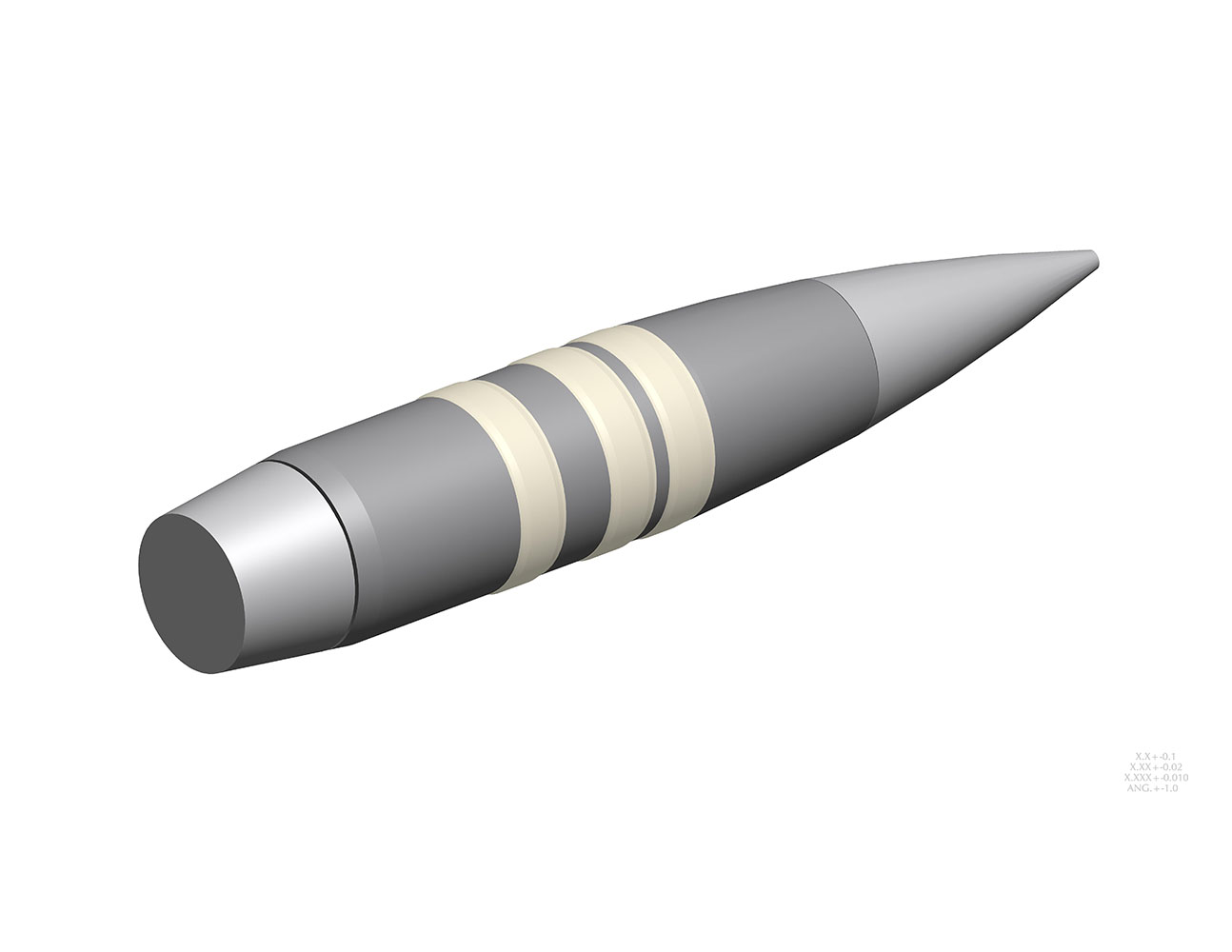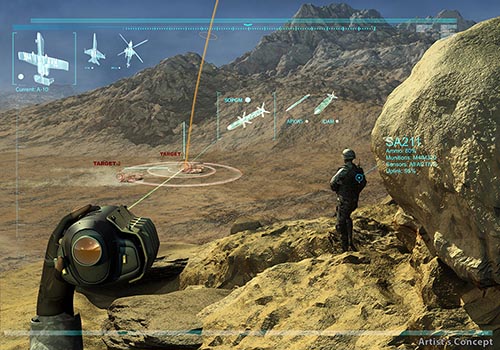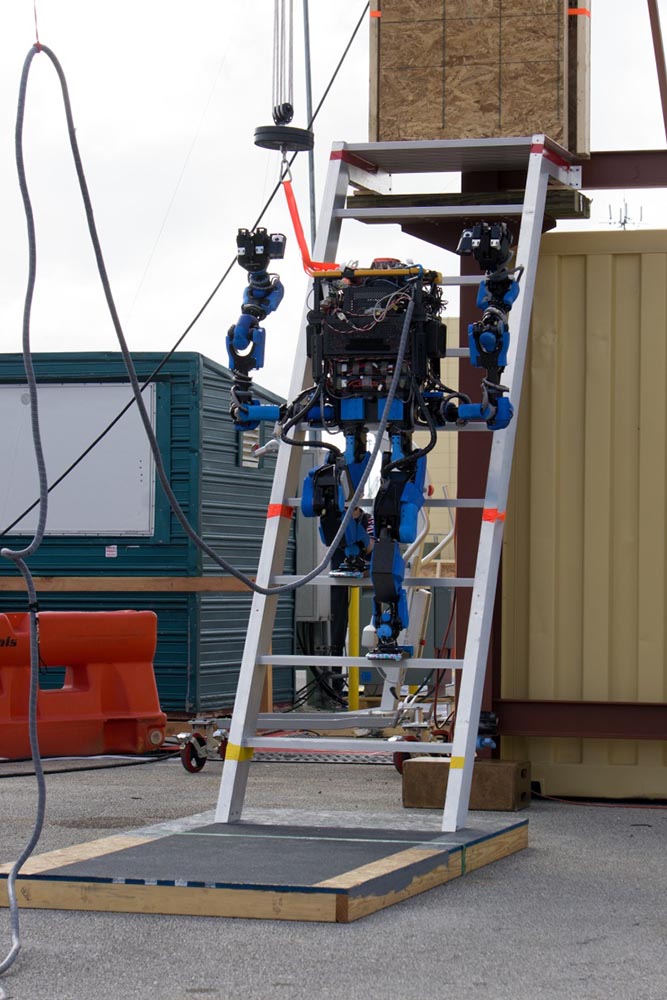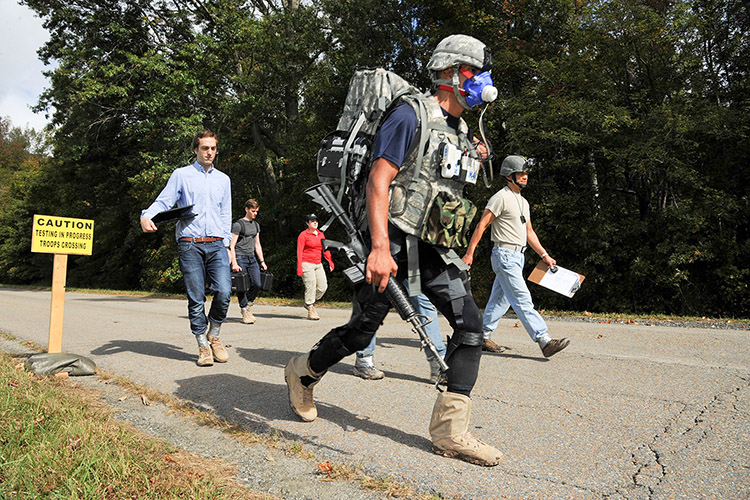
ACCESS AL&T talks to DARPA about standing conventional wisdom on its head
As the U.S. Army Acquisition Support Center (USAASC) communications staff was exploring the issues surrounding Force 2025 and Beyond, we wanted input from that most futuristic part of DOD, the Defense Advanced Research Projects Agency (DARPA), which is renowned for its many breakthroughs and technological disruptions. ACCESS AL&T spoke to Dr. Bradford Tousley, who has been director of the Tactical Technology Office (TTO) at DARPA since January 2013. He holds a B.S. from the United States Military Academy at West Point, and an M.S. and Ph.D. in electrical engineering from the University of Rochester. After a distinguished military career, directing TTO is Tousley’s second stint at DARPA.
ACCESS: TTO’s vision is “to rapidly develop new prototype military capabilities that create an asymmetric technological advantage and provide U.S. forces with decisive superiority and the ability to overwhelm our opponents.” What does TTO do to make this vision a reality?
TOUSLEY: To help you understand TTO, let me first explain how DARPA works as a whole. Through more than five decades of tumultuous geopolitical and technological change, DARPA has focused on our crystal-clear mission: making pivotal early investments in game-changing technologies for national security. We bring the best of those ideas to fruition by providing the right mix of research support, intellectual freedom and responsible oversight to outstanding performers in industry, academia and other government organizations. We facilitate the transition and operationalization of these new, paradigm-shifting capabilities to give the nation technology-based options for preventing—and creating—strategic surprise. DARPA has demonstrated time and again how thinking beyond the borders of what is widely considered possible can yield extraordinary results.
TTO’s role within DARPA is to focus on very high-payoff, high-risk development of revolutionary new platforms, weapons, critical technologies and systems. Our investments encompass interdisciplinary research into enabling capabilities across four primary mission domains: ground, maritime/undersea, air and space. We also explore advances in cooperative autonomy, unmanned systems and power and propulsion systems.

One of the projects involving TTO is the Aerial Reconfigurable Embedded System, the goal of which is to provide flexible, terrain-independent transportation that avoids ground-based threats, in turn supporting expedited, cost-effective operations and improving the likelihood of mission success. The program aims to develop and demonstrate a modular transportation system built around a vertical takeoff and landing flight module that would carry one of several different types of detachable mission modules. (Image courtesy of DARPA)
Rapid agile development and improving affordability are two key themes across all TTO programs. That’s because DARPA understands that it is not enough to develop new and even extraordinary technical capabilities; the agency’s work is not done until those technologies are making a difference. Even before a program launches, we start developing strategies for transitioning anticipated results into applicable, real-world domains. Agile systems development and affordability are essential to those strategies and to encourage buy-in from the services. Those aspects are also crucial to DARPA’s goal to “invert the cost equation,” by which we want to force adversaries to pay much more in their attempts to counter our groundbreaking capabilities than we pay to develop and field them.
ACCESS: Where do you get your best ideas? Your “TTO Opportunities” seem to be a combination of both broadly and narrowly defined solicitations. DARPA has also used contests to find great ideas. What are the advantages and challenges in each approach?
TOUSLEY: DARPA gets ideas from many sources, but the main one is our stellar program managers (PMs), who come from the services, academia, industry, national laboratories and other parts of government. They come to DARPA with inspirations about achieving breakthroughs in technologies that stand conventional wisdom on its head, mindful of the rare opportunity to bring about disruptive changes that contribute to our national security.
Traditionally validated program requirements tend to start with existing concepts and seek only measured improvements that appear achievable and affordable. DARPA approaches development from the other direction, saying, “If I prove that there’s technology that can do A, B or C, what could you do with that?” We keep PMs onboard typically for three to five years, which provides the advantage of continuously infusing the agency with new people and fresh views and helps drive DARPA’s signature sense of urgency.

The goal of DARPA’s Extreme Accuracy Tasked Ordnance (EXACTO) program is to revolutionize rifle accuracy and range by developing the first-ever guided small-caliber bullet. The system combines a maneuverable bullet and a real-time guidance system to track and deliver the projectile to the target, allowing the bullet to change path during flight to compensate for any unexpected factors that may drive it off course. (Image courtesy of DARPA)
Another key source of program ideas is the robust innovation ecosystem that includes DARPA’s academic, corporate and governmental partners. DARPA has helped create new communities of scientists and engineers, both inside and beyond the traditional defense community, by focusing its efforts at the boundaries of knowledge and at the edges and intersections of disciplines. Along the way, companies and sometimes entire industries have sprung from DARPA-funded research. We gather their ideas through many standard contracting means, including Proposers’ Days, Broad Agency Announcements (BAAs), special notices and requests for information.
DARPA has also sponsored numerous challenges over the last 12 years, most recently TTO’s own DARPA Robotics Challenge, which will hold its finals in June 2015 in Pomona, California. DARPA challenges use prize-based competitions to attract novel performers and ideas from beyond the traditional defense performer base. By tapping into the ingenuity of the wider research community and encouraging collaboration across diverse fields, DARPA seeks to encourage new waves of research and development to spur continued innovation, encourage commercial investment and lower the cost of advanced technologies.
ACCESS: What does DARPA do differently from the Army acquisition community to identify and make optimal use of revolutionary new capabilities? Are there any techniques or processes that Army acquisition could adapt to engage industry and academia and share information with them, or does DARPA operate under entirely different authority?
TOUSLEY: DARPA’s mission within DOD’s science and technology (S&T) community is unique. Instead of seeking incremental advances in existing technology and capabilities, we invest in opportunities for potentially transformational change that often involve significant risk. These efforts tend not to originate from the conventional requirements-based processes. We work closely with our colleagues in the services’ S&T organizations, sometimes building on their early research and drawing on their technical expertise, and often relying on them to help us transition successful results to military use.
Some of the factors that have contributed to DARPA’s success over the past six decades include the following:
- DARPA’s organizational structure is flat with little hierarchy, which helps ensure the free and rapid flow of information, ideas and decisions.
- DARPA hires creative, independent people with big ideas and empowers them with the authority, flexibility and resources to investigate the possibilities of their technical approaches. DARPA PMs are hired for finite periods and are expected to be domain experts.
- DARPA is a projects-based agency. PMs typically stay three to five years to complete specific assignments, but longer if necessary to facilitate transition. This relatively brief time window forces PMs to focus their efforts on achieving results quickly.
- DARPA does not own or operate its own research labs. We fund the majority of our research at industry locations and universities, and a smaller amount in DOD and other government labs. This approach enables deep engagement with the research and development (R&D) community while enabling our programs to leverage cutting-edge infrastructure and talent as needed to meet DARPA’s evolving research efforts.
- DARPA’s technical and administrative support functions create a productive environment around our PMs that enables them to take bold technology leaps despite their short tenures. Security and legal staff ensure that we have a solid foundation, while contracting, finance and human resources operate with the speed and flexibility that our diverse portfolio demands. Statutes providing specialized hiring authorities and alternative contracting vehicles have also proven critically important.
- DARPA uses solicitation methods focused on disruptive and interdisciplinary approaches, such as BAAs.
ACCESS: What do you see as the greatest obstacles to “agile” and affordable acquisition in current design and development processes? How can you achieve “revolutionary” and “affordable” in the same capability?
TOUSLEY: Affordable acquisition today is driven by a requirements-based process that optimizes affordability and life cycle cost within the traditional acquisition system. “Agile” systems development largely began in the commercial software business world, where the metric for success was a product of reasonable quality delivered in a specified period of time. Essentially, under agile development, requirements may be negotiable, but deadlines for deliverables are not. In many current DARPA programs, we try to attack cost challenges by restricting or making trade-offs regarding the less vital requirements, while maintaining careful attention to time, labor costs and management.
This affordable framework helps create revolutionary products by focusing on the most critical capabilities and technologies. In these programs, we carefully track a prototype system’s bill of materials, recurring and nonrecurring engineering, and labor effort. Comparing potential prototype costs carefully gives us a better estimate of what a similar production variant might cost.

Leveraging advances in computing and communications technologies, DARPA’s Persistent Close Air Support program would enable ground forces and combat aircrews to jointly select and employ precision-guided weapons from a diverse set of airborne platforms. (Image courtesy of DARPA)
ACCESS: With that in mind, the author Steven Johnson, in his book “Where Good Ideas Come From,” posits the 10/10 rule: It takes 10 years to develop an enabling technology and another 10 years to see it fully exploited. On either side of that equation, do you see it really taking that long? If so, are there ways to speed up the exploitation of enabling technologies?
TOUSLEY: It is important to parse the context of discussing the origin of ideas, making a distinction between ideas, exploratory science and technology, applied development and fielded military systems. Steven Johnson makes the point that “ideas are networks” and not “eureka moments.” Indeed, DARPA has repeatedly shown that novel ideas are often found at the intersection between people and fields. It takes time for ideas to foment and emerge in refined form, although no underlying reason exists that this process must take 10 years or more.

DRC participants develop hardware, software, sensors and human-machine control interfaces that will enable their robots to complete a series of challenge tasks selected by DARPA. Team SCHAFT’s S1 robot finished first in the December 2013 DRC trials, scoring the most points in a series of eight challenge tasks related to disaster response. (Photo courtesy of DARPA)
Historical examples abound of rapid and innovative military system development that counter the idea that creating new capabilities must take a decade or longer. The aircraft company North American Aviation took only 117 days from contract to first flight of the P-51 Mustang fighter, which went on to change the course of the European air campaign in World War II. The A-12 Avenger II reconnaissance aircraft (the precursor to the SR-71 Blackbird) went from contract to first flight in about two years, but built on many ideas that had been developing in the aerospace community for a decade or more. In terms of fielding, the initial contract for the Chinook CH-47 helicopter program was let in 1958; the aircraft first flew in 1961 and was in service a year later. The Chinook remains the backbone of U.S. Army rotary-, heavy-cargo mobility to this day.
DARPA owes its reputation for rapid technology development to many factors. A key example is that our technical offices each specialize in certain points in the R&D process: some on foundational science, others on creating component technologies and still others (including TTO) on developing full systems and platforms. Another critical motivator is brief program length and focusing on only a few new but critical technologies at a time.
ACCESS: How does DARPA decide which research to pursue? Do you have the flexibility to adapt to evolving threat environments and mission needs?
TOUSLEY: DARPA has hundreds of programs, and we choose each one based on how it could help achieve our mission: making early pivotal investments in groundbreaking technologies for national security. When deciding whether to pursue a particular program or research area, we consider both the current geopolitical and technological environment and how that landscape might evolve over time. In short, DARPA priorities are informed by national security needs and inspired by advances in technology.
DARPA’s investment strategy begins with a portfolio approach. Reaching for outsize impact means taking on risk, and high risk in pursuit of high payoff is a hallmark of DARPA programs. By design, programs are finite while aiming to create lasting revolutionary change. They address a wide range of technology opportunities and national security challenges. This approach ensures that while individual efforts might fail—a natural consequence of taking on risk—the total portfolio delivers. We start programs by searching for disruptive impacts and readily modify or terminate underperforming efforts.
One major part of the answer is bottom up: DARPA PMs define and propose new programs that they believe promise revolutionary change. This approach is important for several reasons. Effective DARPA PMs are the people closest to the critical challenges and possible technology opportunities in their respective arenas, and their personal inspiration and drive behind novel ideas are vital. More fundamentally, breakthrough technologies that create and prevent surprise rarely come from a consensus starting point. Often the inspiration comes from questioning established trends and ways of doing things.

Army researchers are evaluating prototype devices developed for DARPA with the goal of creating clothing that helps reduce injuries and fatigue while improving mission performance. Spc. Rafael Boza, 1st Infantry Division, tests a prototype “smart suit” at Aberdeen Proving Ground, Maryland, Oct. 3, 2014. (Photo by Tom Faulkner, U.S. Army Research, Development and Engineering Command)
ACCESS: Sometimes the solution to a problem today can also be an enabling technology for the future. For example, the systems or platforms that TTO is currently developing often trace their efficacy, in terms of speed, efficiency, endurance, performance, etc., back to breakthroughs in compact, controllable and robust provision of power or propulsion. Is there a core “virtue,” such as open systems and open architecture, of technologies that DARPA “bakes into” its solutions to enable future expansion for as yet unforeseen applications?
TOUSLEY: The core virtues that DARPA invests in its programs are a set of considerations known as the Heilmeier Catechism. George H. Heilmeier, a former DARPA director, crafted the questions to help standardize evaluation of research programs throughout their life spans, from proposal to transition:
- What are you trying to do? Articulate your objectives using absolutely no jargon.
- How is it done today, and what are the limits of current practice?
- What’s new in your approach, and why do you think it will be successful?
- Who cares? If you’re successful, what difference will it make?
- What are the risks and the payoffs?
- How much will it cost? How long will it take?
- What are the midterm and final “exams” to check for success?
ACCESS: In a similar vein, truly inventive technologies initially may not receive widespread support from stakeholders who could benefit from them. How do you keep an open mind when something comes along that is so far outside of the norm that it seems impossible?
TOUSLEY: DARPA PMs and leadership communicate regularly with stakeholders and partners to help ensure that our research meets actual needs now and in the future. We share the progress of technology projects and seek partner input for potential concepts of operation and relevant testing to demonstrate the technology’s application to domain impact. These periodic updates help us avoid situations where stakeholders ask, “How do you expect me to use that?”
ACCESS: What are some of the most exciting or promising developments that have come, or are coming, out of TTO that could affect the force by 2025? By 2040?
TOUSLEY: DARPA is always doing a lot of exciting work, and TTO is no exception. Some specific programs about which we are particularly excited include:
- Persistent Close Air Support (PCAS): PCAS aims to enable ground forces and combat aircrews to jointly select and employ precision-guided weapons from a diverse set of airborne platforms. The program seeks to leverage advances in computing and communications technologies to fundamentally improve the speed, effectiveness and survivability of ground forces engaged with enemy forces.
- Aerial Reconfigurable Embedded System (ARES): ARES aims to develop and demonstrate a modular transportation system built around a vertical takeoff and landing flight module operated as an unmanned aerial vehicle. The flight module would carry one of several different types of detachable mission modules, each designed for a specific purpose, such as intelligence, surveillance and reconnaissance, casualty evacuation and cargo resupply. The program seeks to provide flexible, terrain-independent transportation that avoids ground-based threats, in turn supporting expedited, cost-effective operations and improving the likelihood of mission success.
- Aircrew Labor In-cockpit Automation System (ALIAS): ALIAS envisions a tailorable, drop‐in, removable kit that would enable the addition of high levels of automation into existing aircraft to enable operation with reduced onboard crew. The program intends to leverage the considerable advances that have been made in aircraft automation systems over the past 50 years, as well as the advances made in remotely piloted aircraft automation, to help reduce pilot workload, augment mission performance and improve aircraft safety.
- Extreme Accuracy Tasked Ordnance (EXACTO): EXACTO seeks to improve sniper effectiveness and enhance troop safety by increasing shooter standoff range and reducing target engagement timelines. EXACTO’s specially designed ammunition and real-time optical guidance system help track and direct projectiles to their targets by compensating for weather, wind, target movement and other factors that could impede successful hits.
- Squad X: Squad X aims to build a digitized, integrated system of systems to organically extend squad awareness and influence. The goal is to provide overwhelming tactical superiority at the small-unit level by enabling squad members to more quickly and effectively collect, synthesize and share data about their fellow members, their environment and potential threats without increasing physical or cognitive burdens.
- Ground X-Vehicle Technologies (GXV-T): GXV-T seeks to investigate revolutionary ground-vehicle technologies that would simultaneously improve the mobility and survivability of vehicles through means other than adding more armor, including avoiding detection, engagement and hits by adversaries. This improved mobility and warfighting capability would enable future U.S. ground forces to more efficiently and cost-effectively tackle varied and unpredictable combat situations.
ACCESS: What would readers be most surprised to learn about DARPA that they don’t already know?
TOUSLEY: DARPA has enormous respect for and vested interest in the institutional legacy and history of the U.S. Army. In much the same way that the Army values core Soldier attributes and leadership while depending on both, DARPA also depends on the vision, drive and domain expertise of its PMs to deliver breakthrough capabilities for national security. By working together effectively, the Army and DARPA can accomplish great advancements in support of Force 2025 and Beyond.

The primary technical goal of DARPA’s Robotics Challenge (DRC) is to develop human-supervised ground robots that can be used in responding to natural and man-made disasters. The competition, which is designed to be extremely difficult, includes some of the most advanced robotics research and development organizations in the world. (Image courtesy of DARPA)
For more articles about Force 2025, read the January – March 2015 Army AL&T magazine.
Subscribe to Access AL&T is the premier online news source for the Acquisition, Logistics, and Technology (AL&T) Workforce.
![]() Subscribe
Subscribe







